Abstract
Two mutants of Saccharomyces cerevisiae have been isolated and characterized. The mutants were constitutively agglutinable at 36 degrees C, the temperature at which wild-type cells agglutinate only after induction by mating pheromone. The mutant cells had other properties specific for the normal alpha cell type, i.e., conjugation with a cells, response to a mating pheromone, and production of alpha mating pheromone. The two mutations, cag1 and cag2, were recessive and expressed only in alpha cells. cag1 is linked very closely to the MAT locus, but cag2 is unlinked to the MAT locus. These cag mutations complemented ste3-1. These results indicate that CAG genes are novel alpha-specific genes involved in the regulation of sex agglutinin synthesis.
Full text
PDF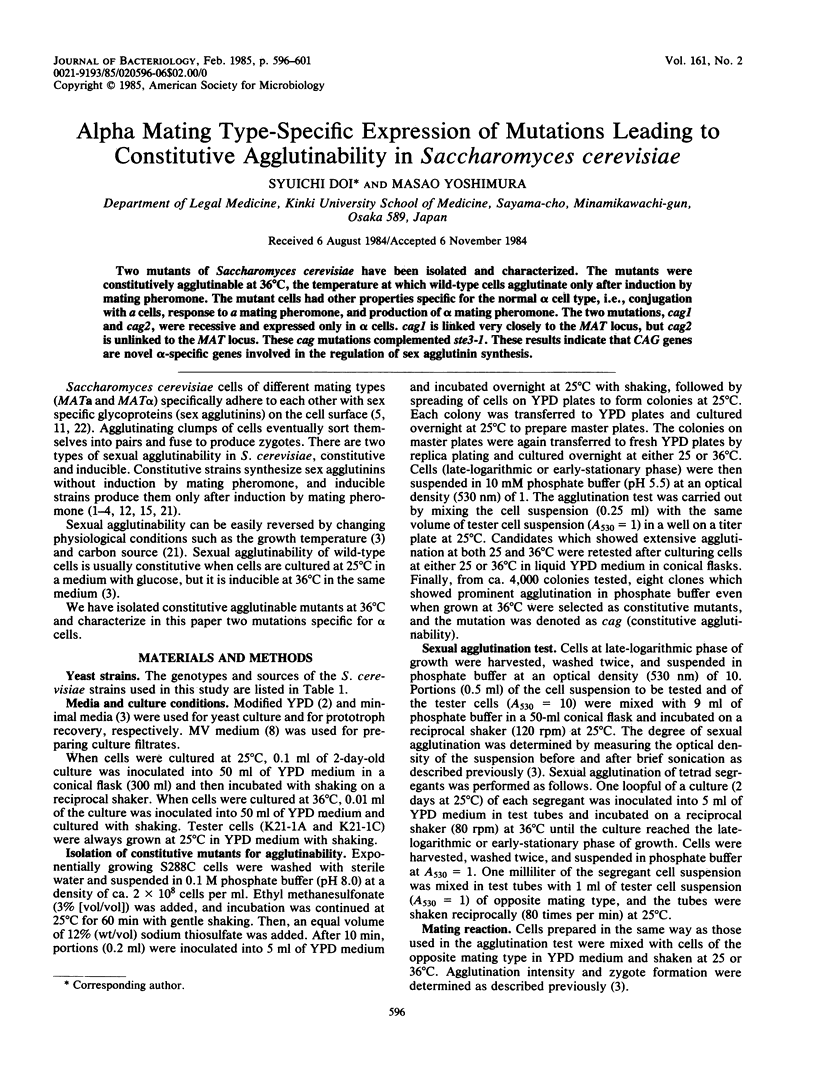
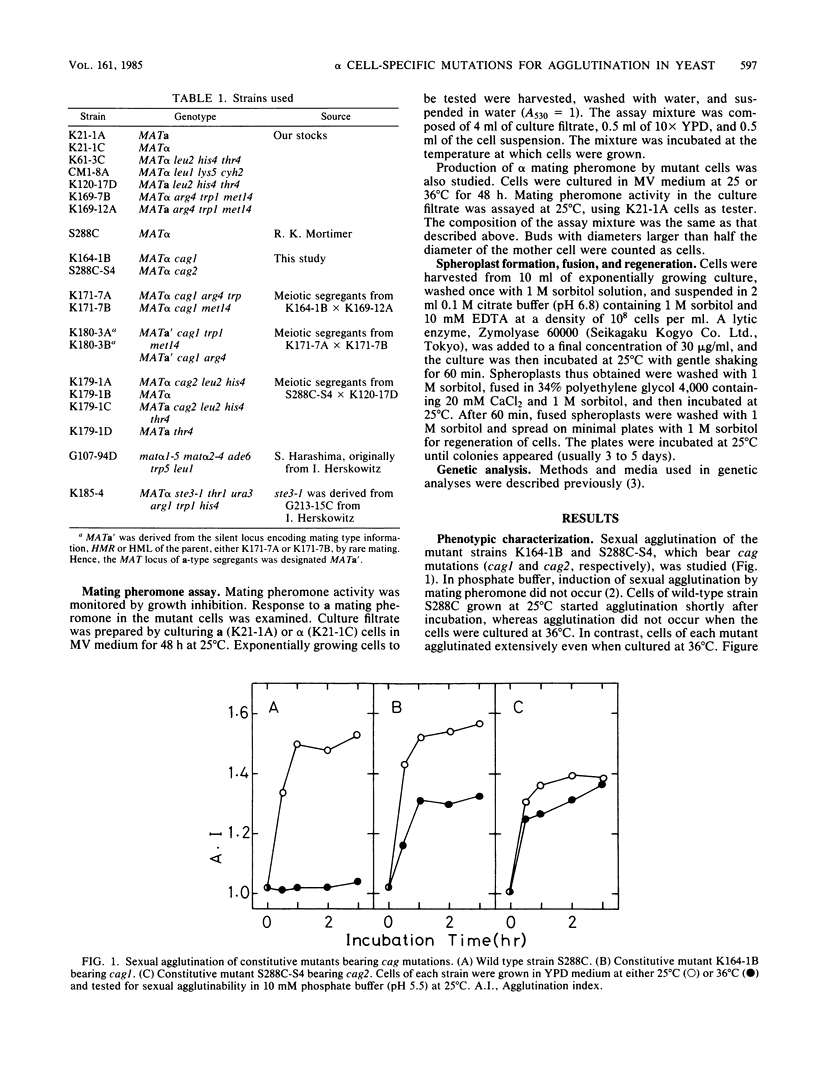
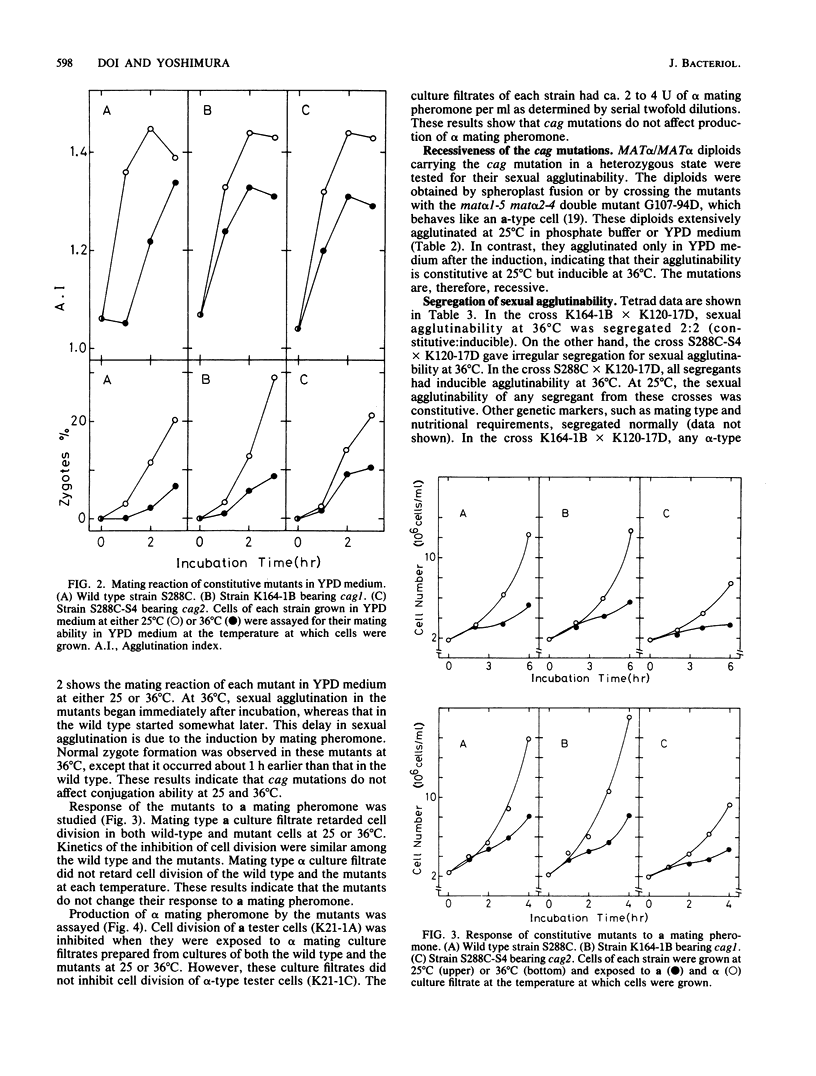
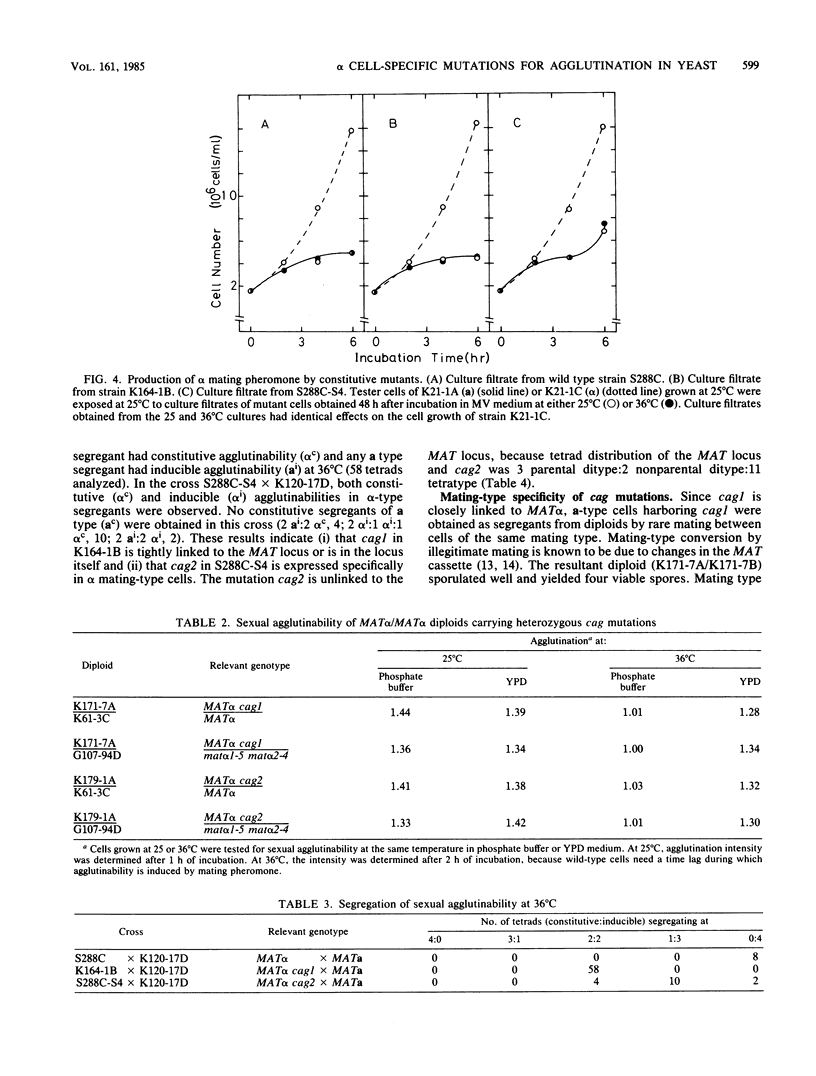
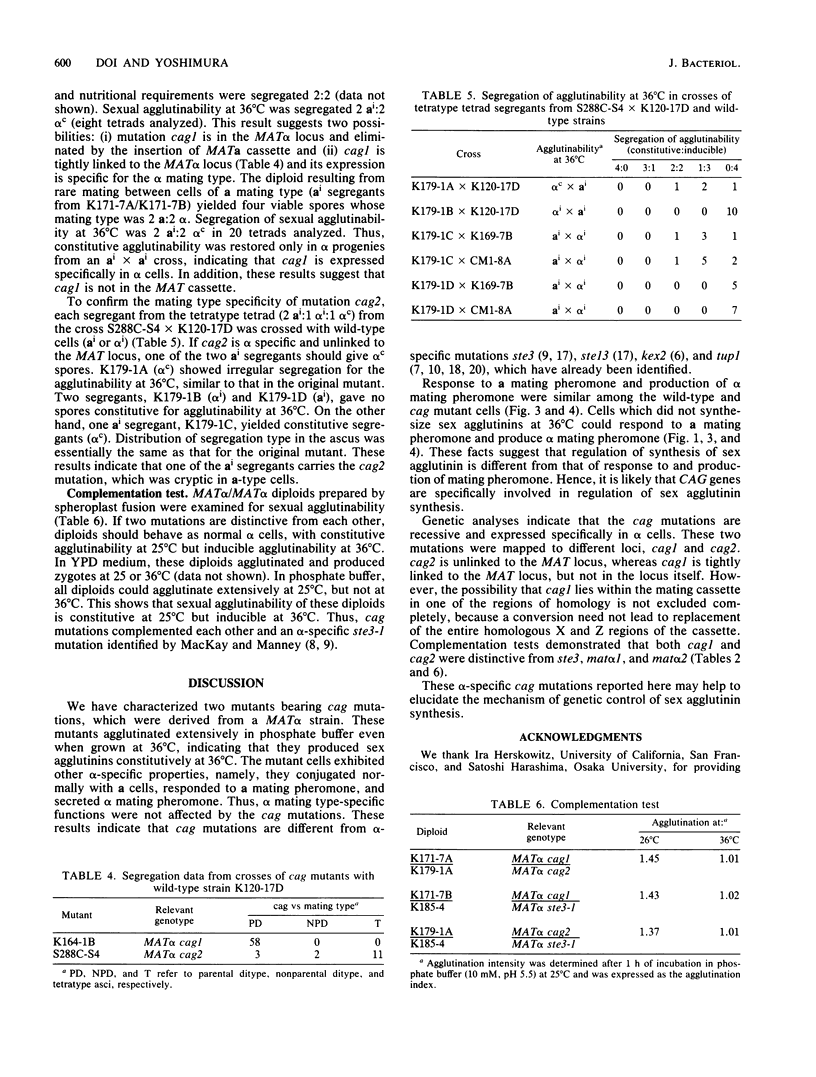
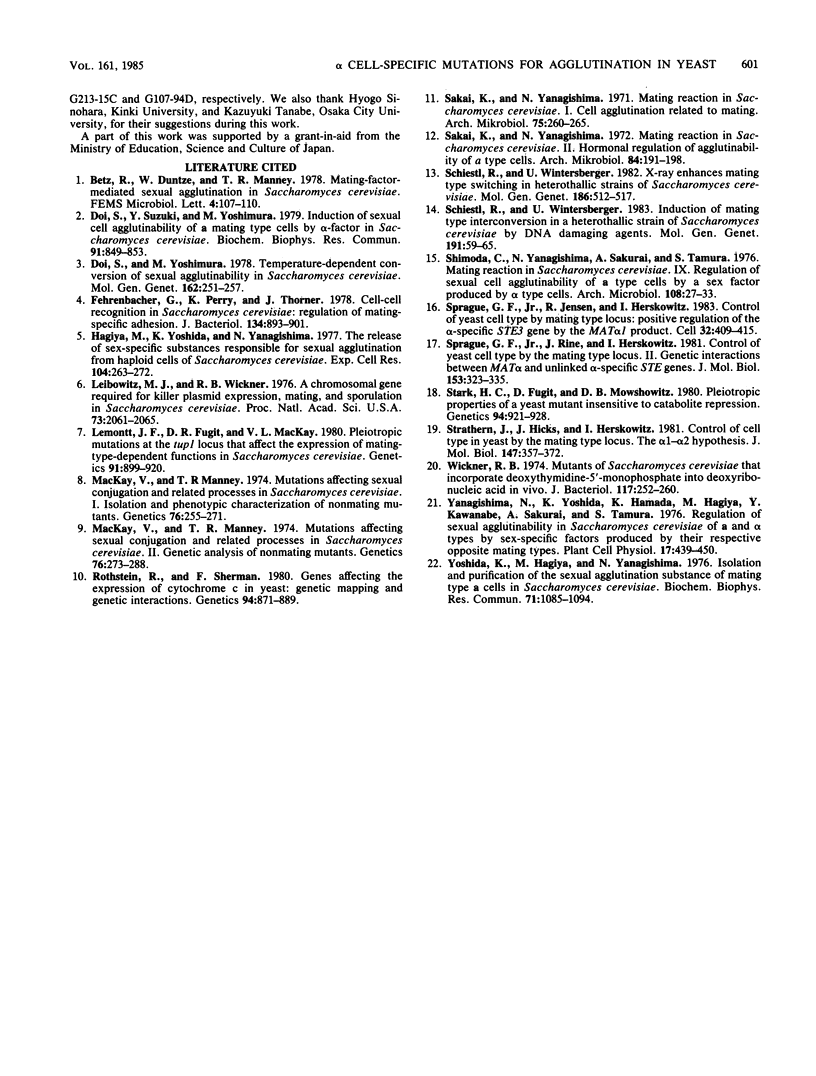
Selected References
These references are in PubMed. This may not be the complete list of references from this article.
- Doi S., Suzuki Y., Yoshimura M. Induction of sexual cell agglutinability of A mating type cells by alpha-factor in Saccharomyces cerevisiae. Biochem Biophys Res Commun. 1979 Dec 14;91(3):849–853. doi: 10.1016/0006-291x(79)91957-0. [DOI] [PubMed] [Google Scholar]
- Fehrenbacher G., Perry K., Thorner J. Cell-cell recognition in Saccharomyces cerevisiae: regulation of mating-specific adhesion. J Bacteriol. 1978 Jun;134(3):893–901. doi: 10.1128/jb.134.3.893-901.1978. [DOI] [PMC free article] [PubMed] [Google Scholar]
- Hagiya M., Yoshida K., Yanagishima N. The release of sex-specific substances responsible for sexual agglutination from haploid cells of Saccharomyces cerevisiae. Exp Cell Res. 1977 Feb;104(2):263–272. doi: 10.1016/0014-4827(77)90090-8. [DOI] [PubMed] [Google Scholar]
- Leibowitz M. J., Wickner R. B. A chromosomal gene required for killer plasmid expression, mating, and spore maturation in Saccharomyces cerevisiae. Proc Natl Acad Sci U S A. 1976 Jun;73(6):2061–2065. doi: 10.1073/pnas.73.6.2061. [DOI] [PMC free article] [PubMed] [Google Scholar]
- Lemontt J. F., Fugit D. R., Mackay V. L. Pleiotropic Mutations at the TUP1 Locus That Affect the Expression of Mating-Type-Dependent Functions in SACCHAROMYCES CEREVISIAE. Genetics. 1980 Apr;94(4):899–920. doi: 10.1093/genetics/94.4.899. [DOI] [PMC free article] [PubMed] [Google Scholar]
- Mackay V., Manney T. R. Mutations affecting sexual conjugation and related processes in Saccharomyces cerevisiae. I. Isolation and phenotypic characterization of nonmating mutants. Genetics. 1974 Feb;76(2):255–271. doi: 10.1093/genetics/76.2.255. [DOI] [PMC free article] [PubMed] [Google Scholar]
- Mackay V., Manney T. R. Mutations affecting sexual conjugation and related processes in Saccharomyces cerevisiae. II. Genetic analysis of nonmating mutants. Genetics. 1974 Feb;76(2):273–288. doi: 10.1093/genetics/76.2.273. [DOI] [PMC free article] [PubMed] [Google Scholar]
- Rothstein R. J., Sherman F. Genes affecting the expression of cytochrome c in yeast: genetic mapping and genetic interactions. Genetics. 1980 Apr;94(4):871–889. doi: 10.1093/genetics/94.4.871. [DOI] [PMC free article] [PubMed] [Google Scholar]
- Sakai K., Yanagishima N. Mating reaction in Saccharomyces cerevisiae. I. Cell agglutination related to mating. Arch Mikrobiol. 1971;75(3):260–265. doi: 10.1007/BF00408986. [DOI] [PubMed] [Google Scholar]
- Sakai K., Yanagishima N. Mating reaction in Saccharomyces cerevisiae. II. Hormonal regulation of agglutinability of a type cells. Arch Mikrobiol. 1972;84(3):191–198. doi: 10.1007/BF00425197. [DOI] [PubMed] [Google Scholar]
- Schiestl R., Wintersberger U. Induction of mating type interconversion in a heterothallic strain of Saccharomyces cerevisiae by DNA damaging agents. Mol Gen Genet. 1983;191(1):59–65. doi: 10.1007/BF00330890. [DOI] [PubMed] [Google Scholar]
- Schiestl R., Wintersberger U. X-ray enhances mating type switching in heterothallic strains of Saccharomyces cerevisiae. Mol Gen Genet. 1982;186(4):512–517. doi: 10.1007/BF00337958. [DOI] [PubMed] [Google Scholar]
- Sprague G. F., Jr, Jensen R., Herskowitz I. Control of yeast cell type by the mating type locus: positive regulation of the alpha-specific STE3 gene by the MAT alpha 1 product. Cell. 1983 Feb;32(2):409–415. doi: 10.1016/0092-8674(83)90460-9. [DOI] [PubMed] [Google Scholar]
- Sprague G. F., Jr, Rine J., Herskowitz I. Control of yeast cell type by the mating type locus. II. Genetic interactions between MAT alpha and unlinked alpha-specific STE genes. J Mol Biol. 1981 Dec 5;153(2):323–335. doi: 10.1016/0022-2836(81)90281-3. [DOI] [PubMed] [Google Scholar]
- Stark H. C., Fugit D., Mowshowitz D. B. Pleiotropic properties of a yeast mutant insensitive to catabolite repression. Genetics. 1980 Apr;94(4):921–928. doi: 10.1093/genetics/94.4.921. [DOI] [PMC free article] [PubMed] [Google Scholar]
- Strathern J., Hicks J., Herskowitz I. Control of cell type in yeast by the mating type locus. The alpha 1-alpha 2 hypothesis. J Mol Biol. 1981 Apr 15;147(3):357–372. doi: 10.1016/0022-2836(81)90488-5. [DOI] [PubMed] [Google Scholar]
- Wickner R. B. Mutants of Saccharomyces cerevisiae that incorporate deoxythymidine-5'-monophosphate into deoxyribonucleic acid in vivo. J Bacteriol. 1974 Jan;117(1):252–260. doi: 10.1128/jb.117.1.252-260.1974. [DOI] [PMC free article] [PubMed] [Google Scholar]
- Yoshida K., HAGIYA M., Yanagishima N. Isolation and purification of the sexual agglutination substance of mating type a cells in Saccharomyces cerevisiae. Biochem Biophys Res Commun. 1976 Aug 23;71(4):1085–1094. doi: 10.1016/0006-291x(76)90765-8. [DOI] [PubMed] [Google Scholar]


